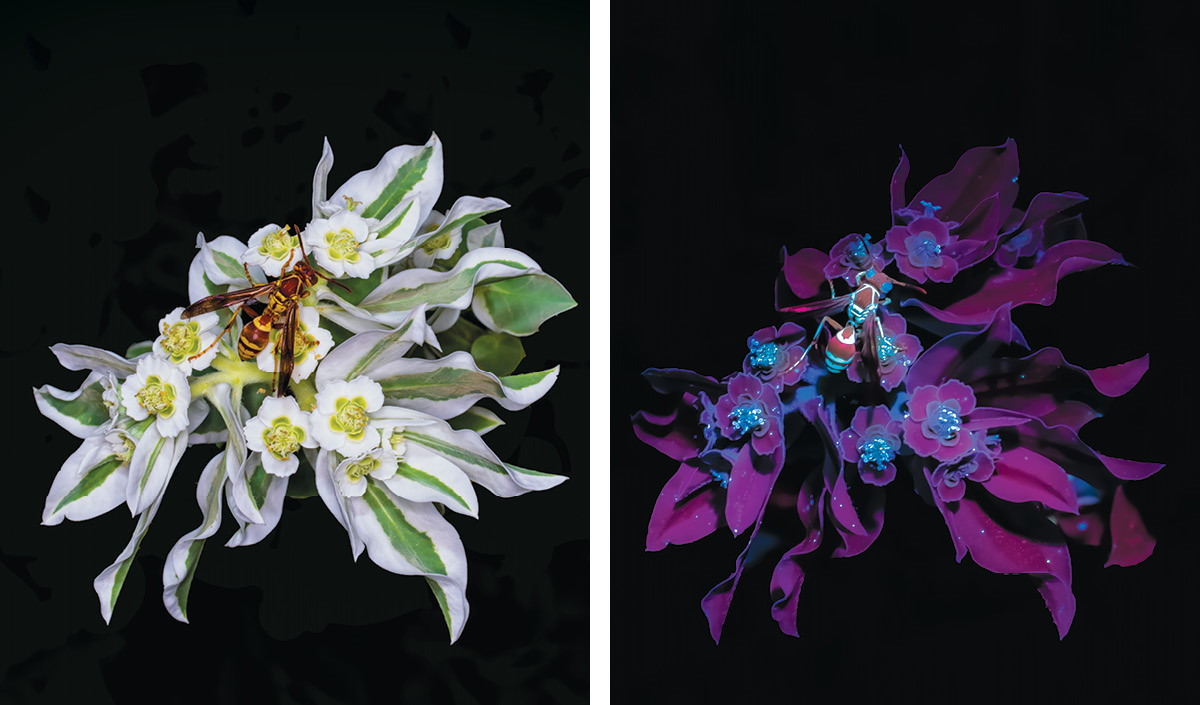
A Different Light
All photos by Michelle Wong
In the all-important quest for pollinators, plants really pull out the stops, producing flowers with powerful scents, dramatic colors and elaborate structures. The end goal: to entice a bee, butterfly or other insect to land and, ultimately, transfer pollen from one flower to another.
Some plants evolved color patterns that are visible in the ultraviolet portion of the electromagnetic light spectrum, which humans cannot see but many insects can. With so many species of flowering plants and of insects, scientists know very little about exactly who pollinates what, or why, but numerous studies have shown that these UV patterns strongly influence pollinator visitation to the flowers that have them.
“The patterns are like little maps, showing insects where the pollen is,” says Dr. Karen Clary, the Center’s former (now-retired) director of plant conservation. “Pollinators smell a flower first, so they know it’s there, and color is the landing pad that pulls them forward. It’s intricate and beautiful how flowers have developed a system of luring pollinators.”
The electromagnetic spectrum refers to the range of electromagnetic radiation, or light energy, that travels as waves and spreads out as it goes. The spectrum goes from radio waves with very long wavelengths at one end to very short wavelength X-rays and gamma rays at the other. Visible light — what humans see — occupies a tiny spot in the middle bookended by infrared and ultraviolet light.
When light hits an object, the object absorbs some of the light and reflect the rest. Our brains perceive the reflected light in the wavelengths visible to us, interpreting them as red, orange, yellow, green, blue and violet. Insects can perceive a wider portion of the light spectrum and see colors based on ultraviolet light as well as blue and green (and while they can see reddish wavelengths, they don’t have photoreceptors for the color red itself).
Humans can get a small taste of the insect visual world through UV photography. Michelle Wong, who took the images featured here, became interested in this art form through her involvement with iNaturalist. The app and social network enables naturalists, citizen scientists and biologists to map and share observations of plants and animals.
Thanks to an energetic dog, Wong started taking walks at night, recording observations on the app along the way. “I was seeing a ton of moths and started wondering how they find the specific flowers that they pollinate,” she says. “I started using UV reflective photos and noticed most of the native plants that attract so many pollinators have good UV reflection.” She also began following the Instagram account of California photographer Craig Burrows, who started taking photographs in 2010 based on an interest in nature, particularly insects and plants, and began practicing UV photography in 2014.
Wong says she learned a lot from Burrows. “UV photography is kind of complicated. I had to do a lot of testing, and you need the right equipment.”
UV photos use either reflected or induced fluorescence. (Fluorescence refers to the emission of light by an object after it absorbs light. Usually, the emitted light has a longer wavelength and lower energy than the light that was absorbed. It’s all about molecules and energy states.) Reflected UV photography uses a filter that allows UV light to pass through and blocks visible and infrared light. Ultraviolet-induced visible fluorescence (UVIVF) photography blocks UV light and allows the visible light reflected by the subject (or its fluorescence) through, which is what creates the image.
A normal camera has a built-in filter that blocks most infrared and ultraviolet light, so photographs look like what our eyes see. Wong says a camera store can convert a regular camera into a UV one. She adds that it is possible to take UV reflective photos with any camera, including a smartphone, along with a UV flashlight. However, not all flashlights that claim to be UV actually are, she cautions.
Clary points out that flowering plants have had 250 million years or so to fine-tune their pollinator attraction game. “Each plant has to find a way to lure its own pollinator and not one that they don’t want,” she says. “Every plant uses a different system to entice a pollinator to visit the same species over and over in order to properly spread the pollen.”
These photos highlight how some native wildflowers use the light spectrum to their advantage.
SNOW ON THE PRAIRIE (Euphorbia bicolor), shown above, blooms from July through October. The starry structures technically are modified leaves, called bracts. Its cousin the poinsettia has bracts as well. In the UVIVF image on the right, the centers of the flowers stand out from the rest of the plant, and its clumps of pollen shine bright white.
As a strategy to help ensure reproduction, many plants welcome multiple pollinators, including wasps, bees, butterflies, beetles and flies. Moths are another common pollinator, but because they come out at night, they are guided more by olfactory cues than visual ones, according to Dr. Felicity Muth, an assistant professor in the integrative biology department at The University of Texas at Austin. Many flowers that rely on moths for pollination are pale but have a strong scent.
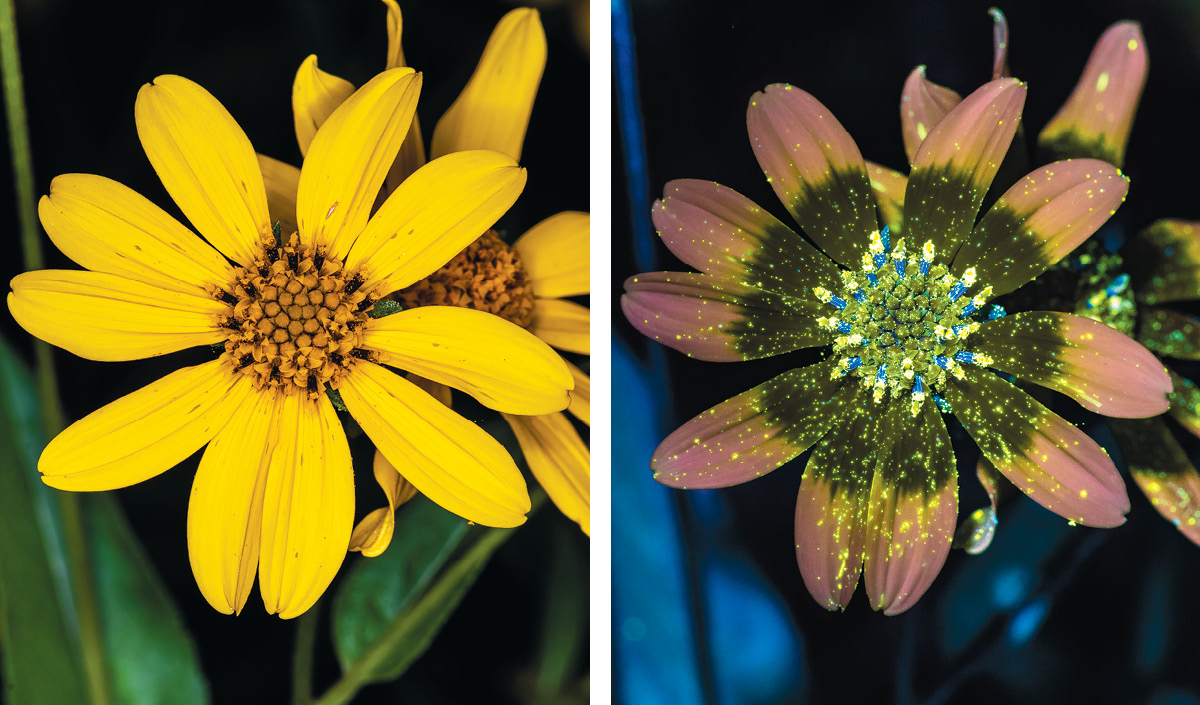
PLATEAU GOLDENEYE (Viguiera dentata) is a tall, bushy plant that tends to grow in colonies, putting out yellow, daisylike flowers in October and November. The UVIVF image on the right shows a classic “bull’s eye” pattern that guides bees and butterflies to the plant’s nectar.
A plant uses little energy to produce nectar, making it a relatively cheap reward for pollinators, Muth says. By contrast, pollen takes a lot of energy to produce, but it also offers pollinators a bigger reward in terms of more nutrition. Plateau goldeneye also is a larval host for cassius blue (Leptotes cassius) and bordered patch (Chlosyne lacinia) butterflies.
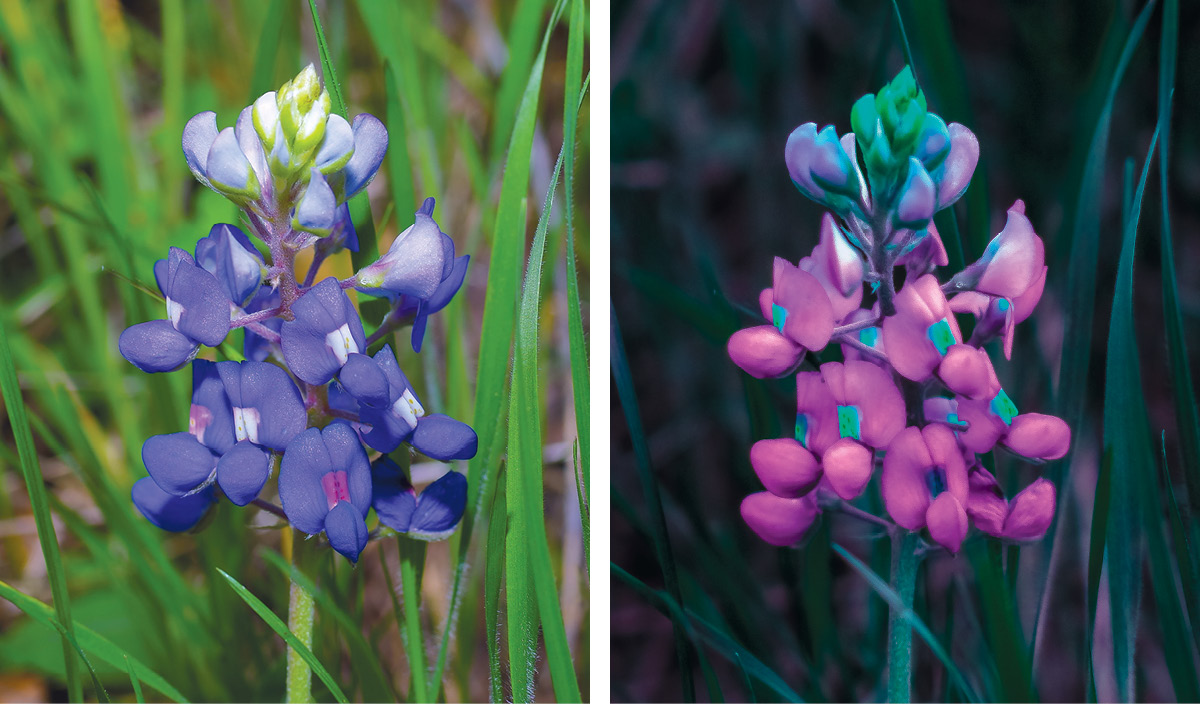
The iconic TEXAS BLUEBONNET (Lupinus texensis) blooms from March through May and attracts bees, especially bumblebees, and butterflies. Bluebonnets also serve as the larval host for hairstreak and elfin butterflies. In the UV photo on the right, the prominent banner spots pop out in bright aqua blue, as compared to white in visible light.
Blue and purple flowers tend to be pollinated by bees, says Muth, as they can see well in that range, while red flowers tend to attract hummingbirds because birds see much better in that range. The insect range of vision explains why most are not attracted to yellow porch lightbulbs the way they are to regular (i.e., white) ones

Often one of the earliest bloomers of the year, ROUNDLEAF RAGWORT (Packera obovata) produces flowers from February to June and attracts bees and butterflies. In the UV image on the far right, the pollen-laden center of the flower is solid green and conspicuous. The middle image uses UVIVF and the left, visible light.
“I often notice that with UV photos of flowers, people write that ‘this is what humans see and this is what bees see,’ but we don’t know the subjective experience of color,” Muth says. Besides perceiving different wavelengths of light, bees see much less clearly than people, and their vision varies at different distances, she explains. For example, a meadow of flowers likely appears as just a blur of color until a bee gets close to specific plants
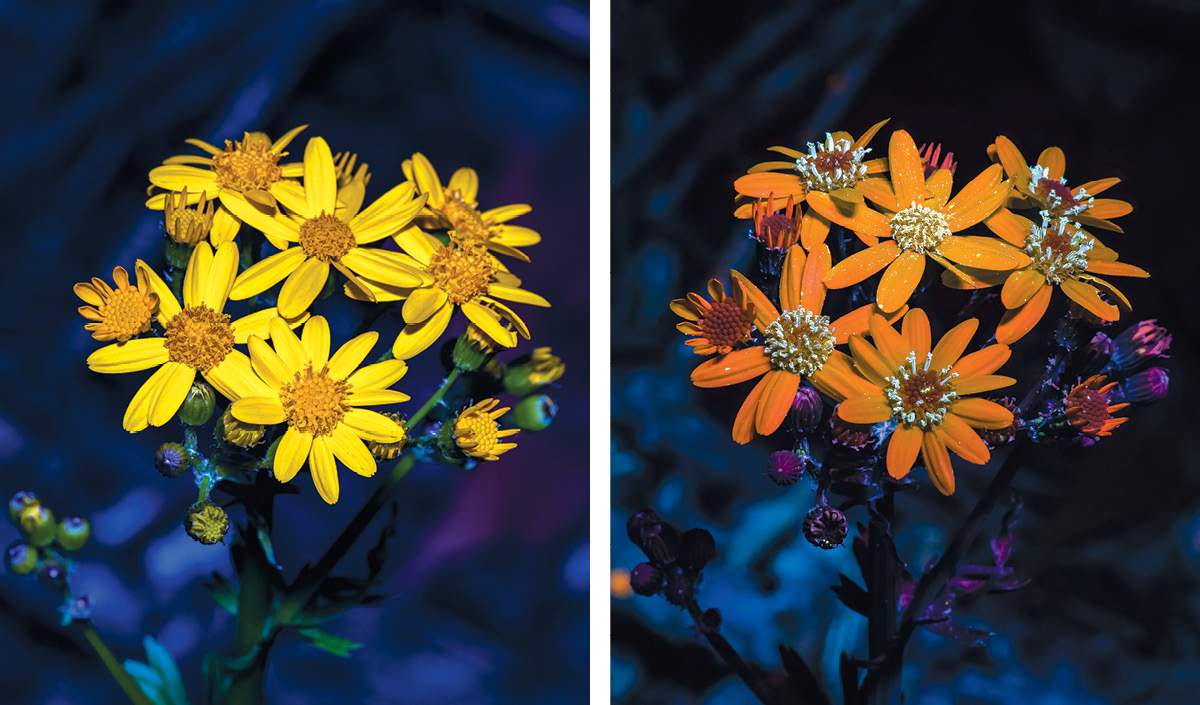
GOLDEN GROUNDSEL (Packera aurea), which blooms from March to August, attracts flies and small bees, including species of nomad, sweat and mining bees. Many families of flies are important pollinators, but scientists know less about their color vision than they do about that of bees. Caterpillars of the gem moth (Orthonama obstipata) feed on the foliage of golden groundsel.
Some flowers create patterns using both absorbance and reflectance of UV light. About a quarter of angiosperm flowers use reflectance, which is highest in yellow flowers like these. In the UVIVF image on the right, pollen stands out starkly against the petals.
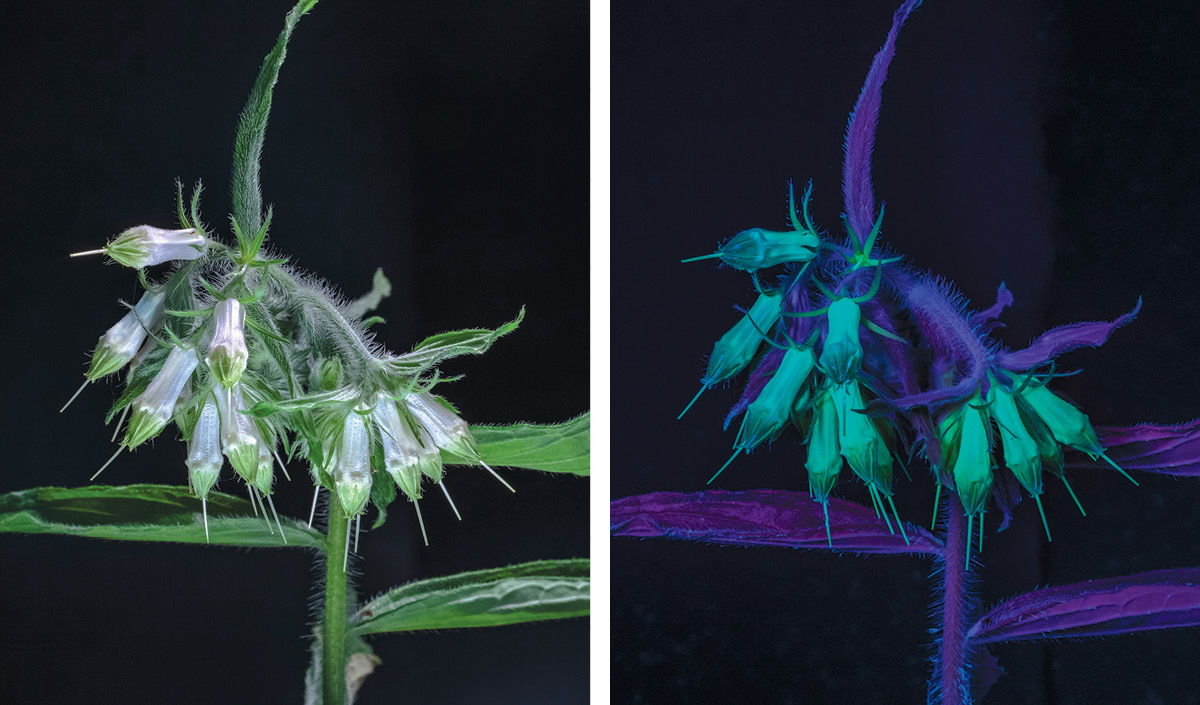
FALSE GROMWELL (Onosmodium bejariense), a perennial, blooms from March to May and attracts butterflies, including monarchs (Danaus plexippus), and a number of species of bumblebees. In the visible light image, left, the flowers are similar in color to the plant, but the lighting in the UVIVF image on the right provides much greater contrast and helps the flowers stand out.
Ultimately, standing out is the goal. It’s how a plant attracts pollinators and, with a little luck, produces the next generation.
Melissa Gaskill writes about science, nature and the environment for a variety of publications, including Texas Climate News, The Revelator and Alert Diver. Her books include “A Worldwide Travel Guide to Sea Turtles” and “Pandas to Penguins: Ethical Encounters with Animals at Risk.”
